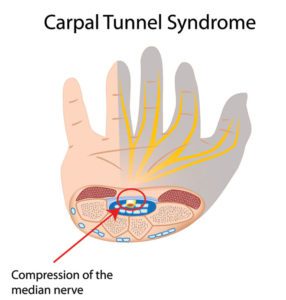

Carpal tunnel syndrome (CTS) is the most common entrapment neuropathy in the body. In simple terms, it is a pinched nerve in the wrist. The carpal tunnel is an anatomic regional that is formed by the carpal (wrist) bones and the transverse carpal ligament, and the median nerve is susceptible to compression within the carpal tunnel. This can occur from inflammation within the carpal tunnel.
What are some common wrist factors for CTS?
Some of the common risk factors for developing CTS include obesity, diabetes, smoking, alcoholism, thyroid disorders, trauma to the wrist or hand, and pregnancy. Repetitive motion activities such as typing, writing, cycling, golfing, and tennis can exacerbate the symptoms.
What are the symptoms of CTS and what most likely happens in its progression?
CTS typically presents with numbness or tingling into the fingers that are innervated by the median nerve. In most people, this involves the thumb, index, middle and part of the ring fingers. It can be intermittent and later become more constant. Night time discomfort and tingling is a very common symptom. As CTS advances and becomes more severe, people can experience weakness and atrophy of certain muscles in the hand. This can also become more permanent and irreversible – so early diagnosis and treatment is important.
How is CTS Diagnosed?
CTS is diagnosed clinically. There are a number of physical exam tests and findings that can be used to accurately diagnose the condition. In addition to exam findings, we will often order a nerve conduction study and electromyogram. This is an in-
office diagnostic test that can objectively confirm the diagnosis and help to assess for other causes of neuropathy.
What conservative measures are available to treat CTS? At what point is surgical treatment considered and what is the recovery process?
CTS can be treated conservatively with wrist splints, home exercises, activity modifications, and occasionally, steroid injections. This is usually more effective when the symptoms are mild. If those options are not effective, and there is good clinical and electro-diagnostic confirmation of the diagnosis, surgical release of the carpal tunnel becomes a good option. Endoscopic carpal tunnel releases have made the recovery relatively easy for most patients. I will often release patients back to golf and tennis by 2 weeks post-operatively.
Any common misconceptions when it comes to Carpal Tunnel Syndrome?
The biggest misconceptions are when patients don’t have significant symptoms, they may think that they don’t have CTS. Also, patients often times think that the recovery can be difficult. I have found patients to be extremely happy with the recovery and their ability to return to activities more quickly than they expected. My best advice is that if someone is experiencing achiness or tingling in the hand, that they address it sooner than later. Early diagnosis and treatment may help to limit long term compromising effects of untreated CTS and avoid surgery.
Scott Greenberg, D.O.
Board Certified Orthopedic Surgeon
Fellowship Trained in Hand and Upper Extremity Surgery
Dr. Greenberg’s offices are located in Naples at Physicians Regional – Collier Blvd, 8340 Collier Blvd, Naples and at Physicians
Regional-Bonita Springs, 24231 Walden Center Drive, Bonita Springs. For more information or to schedule an appointment, please call
239-348-4221, or schedule online at www.PhysiciansRegionalMedicalGroup.com.
 Southwest Florida's Health and Wellness Magazine Health and Wellness Articles
Southwest Florida's Health and Wellness Magazine Health and Wellness Articles

